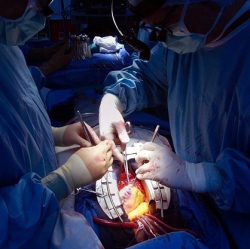
A wireless system uses the same power as a cell phone to safely transmit energy to chips. A Stanford electrical engineer has invented a way to wirelessly transfer power deep inside the body, and use this power to run tiny electronic medical gadgets such as pacemakers, nerve stimulators, or new sensors and devices yet to be developed.
The discoveries reported Monday May 19 in the Proceedings of the National Academy of Sciences (PNAS) culminate years of efforts by Ada Poon, an assistant professor of electrical engineering, to eliminate the bulky batteries and clumsy recharging systems that prevent medical devices from being more widely used.
The technology could provide a path toward a new type of medicine that allows physicians to treat diseases with electronics rather than drugs. “We need to make these devices as small as possible to more easily implant them deep in the body and create new ways to treat illness and alleviate pain,” said Poon.
The PNAS paper describes how Poon’s team built an electronic device smaller than a grain of rice that acts as a pacemaker. It can be powered or recharged wirelessly by holding a power source about the size of a credit card above the device, outside of the body.
